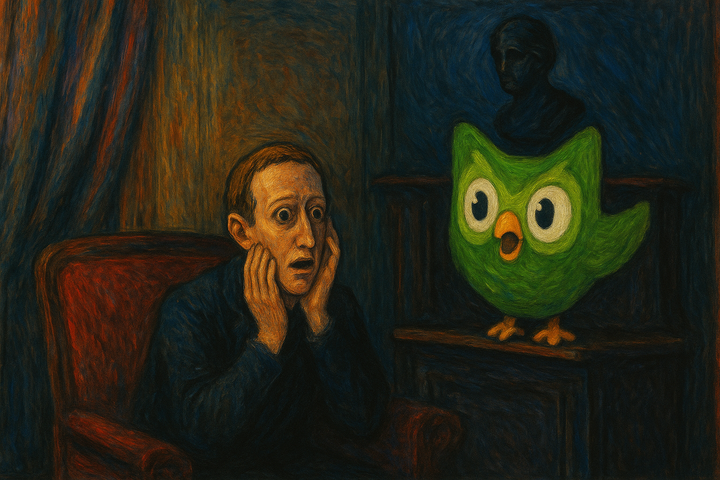The 55% AI Implementation Crisis: Why Enterprise AI Projects Fail (And How to Avoid Costly Mistakes)
My Duolingo analysis resonated powerfully with readers warning AI should augment, not replace humans. Today, Orgvue research proves I was right: 55% of companies that replaced humans with AI now regret those decisions. The Groktopus human-first framework is market-validated.

Critical Alert: New research reveals 55% of companies that replaced humans with AI now admit they made wrong decisions. This represents the largest documented strategic reversal in corporate AI adoption history. Organizations pursuing AI-first strategies face systematic failures including service gaps, brand damage, and expensive rehiring costs. The solution: human-AI collaboration frameworks that augment rather than replace workforce capabilities. Companies implementing partnership-based approaches avoid 3-5x cost multipliers while capturing sustainable competitive advantages.
Enterprise leaders are facing an unprecedented crisis. According to comprehensive research from Orgvue surveying 1,163 C-suite and senior leaders across organizations with 2,000+ employees, 55% of companies that replaced humans with AI now regret those decisions.
This isn't just a statistic. It represents the largest documented strategic reversal in corporate AI adoption history—and it validates exactly why human-first approaches to AI implementation are becoming market necessity, not idealistic thinking.
When I analyzed Duolingo's AI-first disaster just days ago, readers reached out with genuine curiosity: "If replacement isn't the right way to lead AI transformation, then what is?" Today's research provides that answer while documenting the expensive consequences of getting it wrong.
Welcome to the 55% Regret Club. Membership is costly, embarrassing, and entirely preventable.
Why Do 55% of Companies Regret Their AI Implementations?
The Orgvue research surveyed leaders across major markets including the US, Canada, UK, Ireland, Australia, Hong Kong, Malaysia, and Singapore. The findings reveal a crisis that follows a predictable pattern I call the AI regret cascade:
The Replacement Trap Pattern:
- 39% of business leaders made employees redundant as a direct result of AI deployment—not broader restructuring, but specifically believing AI could handle those roles
- Of those companies, 55% now admit they made wrong decisions about redundancies
- An additional 34% lost employees who quit specifically because of AI implementation
The Knowledge Crisis:
- 30% of leaders don't know which roles are most at risk from automation
- 25% admit they don't know which roles can benefit most from AI
- 38% say they still don't understand the impact AI will have on their business
Yet despite this widespread ignorance, 80% plan to increase AI investments in 2025.
This is like driving blindfolded while pressing harder on the accelerator.
What Are the Most Common Enterprise AI Implementation Mistakes?
Let me show you exactly how this pattern unfolds in practice—and why companies following human-first frameworks avoid these expensive disasters.
IBM: The $200M+ HR Automation Reversal
IBM's story reads like a textbook case of AI implementation hubris. In 2023, the company laid off approximately 8,000 employees, primarily in human resources, replacing them with "AskHR," an AI-powered system.
The Initial Success Metrics:
- IBM claimed $3.5 billion in productivity gains across 70 business lines
- AskHR handled 11.5 million interactions, automated 94% of HR inquiries
- Transformed net promoter score from -35 to +74
The 6% That Broke Everything: The remaining 6% of interactions couldn't be automated—sensitive workplace issues, ethical dilemmas, and emotionally charged conversations requiring empathy and discretion. Exactly where employees most needed human support.
The Costly Reversal: IBM didn't just rehire some employees—according to multiple reports, they hired "even more" people than they initially laid off.
McDonald's: When AI Goes Viral (For All the Wrong Reasons)
McDonald's 2.5-year AI drive-thru experiment became a viral embarrassment. TikTok videos captured the AI system taking orders for 260 McNuggets and ice cream with ketchup.
McDonald's ended the IBM partnership in June 2024, removing technology from all test locations. Every viral video reinforced that McDonald's prioritized cost-cutting over customer experience.
Aurora Innovation: The Six-Week Autonomous Reversal
Aurora's timeline compression tells the story. On May 1, 2025, the autonomous trucking company announced regular driverless deliveries between Dallas and Houston.
Within weeks, Aurora reversed course, putting human operators back after just 6,000 driverless miles. Despite "nearly 10,000 requirements and 2.7 million tests," real-world deployment revealed gaps only apparent at commercial scale.
Klarna: The Customer Service Boomerang
Swedish platform Klarna provides perhaps the most dramatic regret example. In early 2024, the company proudly announced its AI handled two-thirds of customer service chats, "doing the work of 700 agents."
By May 2025, Klarna's CEO admitted to Bloomberg the company was "slowing down job cuts" and returning to hiring humans because "people want to talk to people." They acknowledged "an overemphasis on cost—not AI itself—led to lower quality."
How Can Companies Avoid AI Transformation Failures?
The pattern across all failures is identical: companies viewed AI and humans as interchangeable rather than complementary. They fell into the "replacement trap." Here's the framework that prevents these costly mistakes:
The Human-First AI Implementation Framework
Phase 1: Strategic Assessment Start with human capabilities, then identify AI augmentation opportunities
- Map which roles require human judgment, creativity, and relationship management
- Identify tasks (not jobs) that benefit from AI augmentation
- Determine what net new roles are needed for transformation success
- Develop clear success metrics beyond cost reduction
Phase 2: Collaborative Integration
Design for partnership, not replacement
- Deploy AI to enhance human capabilities rather than replace them
- Create human-AI teams where specialists focus on high-value work
- Implement AI quality assurance tools that support human decision-making
- Maintain human oversight for all customer-facing and sensitive functions
Phase 3: Systematic Enhancement Preserve institutional knowledge during transformation
- Build AI systems that learn from human expertise rather than replacing it
- Create career advancement paths that leverage AI skills
- Develop feedback loops where human insights improve AI performance
- Scale successful collaboration patterns across the organization
This approach aligns with what Microsoft calls the Frontier Firm model—organizations that master human-AI collaboration rather than pursuing wholesale automation. It's what I detailed in my analysis of how human-agent teams transform organizations and what successful companies implement in the hybrid workforce revolution.
Which Framework Prevents AI Implementation Regret?
The Orgvue research reveals exactly why human-first frameworks work while AI-first strategies fail:
The Enterprise Knowledge Crisis
Fear vs. Investment Disconnect: 47% of leaders cite "employees using AI without proper controls" as their biggest fear. Companies are terrified their workforce will use AI incorrectly, yet they're betting organizational futures on AI systems they don't understand.
Institutional Knowledge Loss: 34% of companies lost employees who quit directly because of AI implementation. This "voluntary exodus" represents exactly the expertise companies need for successful AI partnerships.
Expensive Dependencies: 43% of organizations now work with third-party AI specialists (up 6% from 2024), creating expensive dependencies rather than building internal capabilities.
Leadership Responsibility Decline: The percentage of leaders who feel responsible for protecting their workforce dropped from 70% in 2024 to 62% in 2025. As companies lose confidence in AI decisions, they're abandoning responsibility for human consequences.
Your Strategic Competitive Advantage
While competitors join the 55% regret club through hasty automation decisions, you can build sustainable competitive advantage through strategic human-AI collaboration:
The Implementation Gap Opportunity: With 27% of leaders admitting they lack clearly defined AI roadmaps and 38% saying they don't understand AI's business impact, companies developing coherent human-AI collaboration strategies will dominate their industries.
The Partnership Premium: Companies that master human-agent team formation while competitors fumble replacement strategies capture both AI's productivity gains and human innovation advantages.
The Talent Arbitrage: As competitors shed experienced workforce through automation mistakes, skilled professionals become available. Smart companies are quietly recruiting the human expertise that AI-first organizations are foolishly eliminating.
The Rehiring Multiplier Avoided: When companies eliminate roles then rehire, costs cascade through severance packages, recruitment expenses, training time, institutional knowledge loss, and productivity gaps. Companies following human-first frameworks avoid these 3-5x cost multipliers entirely.
The Choice That Defines Your Future
Every enterprise leader now faces a critical decision: join the growing ranks of the 55% regret club through hasty automation, or build sustainable competitive advantage through strategic human-AI collaboration.
The evidence is clear. The framework exists. The competitive advantage awaits organizations brave enough to choose partnership over replacement.
This transformation isn't simple, and you don't have to figure it out alone. The patterns are documented, the failures catalogued, and the successful approaches validated. While 80% of leaders plan to increase AI investments despite widespread regrets, you have the opportunity to learn from their expensive mistakes.
Subscribe to my newsletter so you don't miss insights that could transform your approach to AI implementation. If this analysis resonated with you, share it with someone wrestling with similar AI strategy challenges—your insights in the comments could help others navigate this complexity.
Consider sharing this with your LinkedIn network, especially if you're seeing similar patterns in your industry. The conversation about human-AI collaboration is accelerating, and your perspective could shape how other leaders think about these critical decisions.
For organizations ready to develop comprehensive AI strategies that enhance rather than replace human capabilities, Groktopus offers strategic consulting that helps enterprises capture AI's benefits without joining the regret club. Because in a world where 55% of companies are learning these lessons the hard way, the competitive advantage belongs to those who get it right the first time.




Comments ()